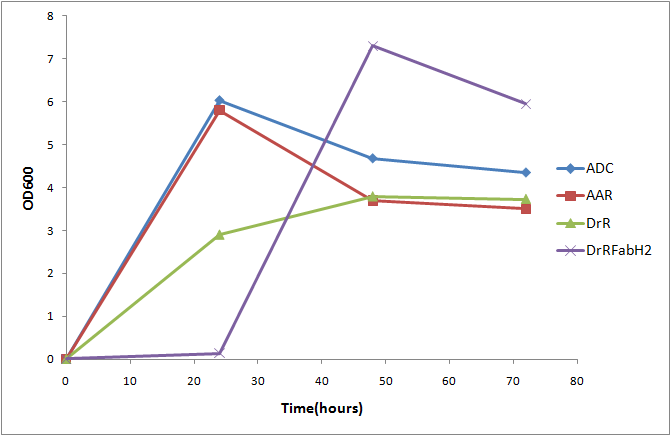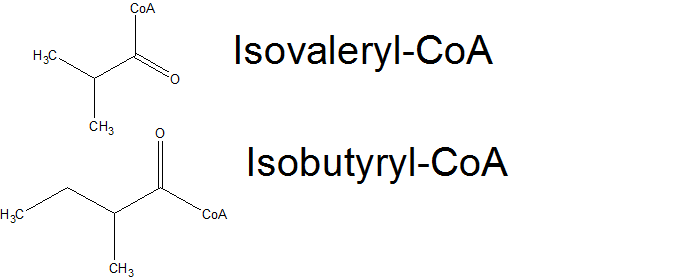Team:Washington/Alkanes/Future/FabH2
From 2011.igem.org
Branched Chain Alkane Production
Background
The basic alkane production system is incapable of making branched chain alkanes, as E. coli normally only makes straight chain fatty acids. We thought that if we could engineer alkane producing E. coli that also makes alkanes, we could make branched chain alkanes, a significant porportion of diesel(reference). One protein whose expression has been previously shown (reference) to cause E. coli to produce branched chain fatty acids is FabH2 from Bacillus subtilis. The FabH family of proteins initiates fatty acid elongation by converting an Acyl-CoA into an Acyl-ACP, with is extended by 2 carbon units to form longer chain length fatty acids. Normally, FabH proteins use a simple 2-carbon acetyl-CoA to start fatty acid biosynthesis, resulting in linear fatty acids. However, FabH2 can also use Isobutyryl-CoA and Isovaleryl-CoA( products from Valine and Leucine degredation)(include images), resulting in 2-methyl branched fatty acid production. If we could use FabH2 and the Petrobrick to get E. coli to produce both alkanes and branched chain fatty acids, we should theoretically be able to produce 2-methyl branched fatty-acids.
Methods
[http://partsregistry.org/wiki/index.php?title=Part:BBa_K590034 FabH2 ] was constructed from oligos( refer to protocol). FabH2 was then amplified to add an [http://partsregistry.org/wiki/index.php?title=Part:BBa_B0034 Elowitz standard RBS]. This RBS-FabH2 contruct was cloned into the 3' end of [http://partsregistry.org/wiki/index.php?title=Part:BBa_K590025 the PetroBrick] to express [http://partsregistry.org/wiki/index.php?title=Part:BBa_K590030 FabH2 as well as AAR and ADC].
Current Results
Throughout our experiments, we observed that cells expressing FabH2 grew significantly slower than any of our other alkane producing cells. In order to quantify this effect, we measured OD600 for alkane production constructs every 24 hours for a 72 hour period, producing a growth curve.

After 24 hours, FabH2 producing cells had barely grown at all, indicating a severe growth deficiency. The cells were able to rapidly grow after 24 hours, presumably due to a mutation that counteracted the nergative effects of FabH2. This toxicity is presumably due to the production of branched chain fatty acids. When branched chain fatty acids are incorporated into the cellular membrane, they would presumably have a negative effect on cell wall integrety by causing gaps in the phosphlipid bilayer. The growth deficiency of Fabh2 producing cells suggests that FabH2 is producing branched chain fatty acids. As of now, we have not been able to produced branched chain fatty acids. It is unlikely that this is due to the inability of AAR/ADC to act on branched chain substrates. Another possibility is that no proper substrates are being produced. Based upon further research,we determined that E. coli does not natively make Isobutyryl-CoA or isovaleryl-CoA. We cannot figure out how (cite) was able to produce branched chain fatty acids, as E. coli doesn't nativly make branched chain CoAs( as far as we can find). If no branched chain fatty acid production is occuring, we do not know why FabH2 causes a severe growth deficiency. Future work will consist of cloning genes that result in branched chain-CoA formation into E. coli
References
1.Beta-ketoacyl-acyl carrier protein synthase III (FabH) is a determining factor in branched-chain fatty acid biosynthesis. Choi KH, Heath RJ, Rock CO. J Bacteriol. 2000 Jan;182(2):365-70.
Parts Submitted
Fill me in!
 "
"



